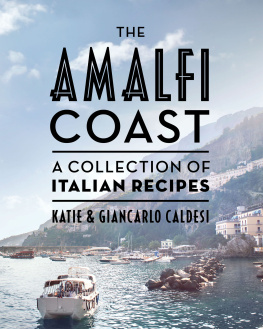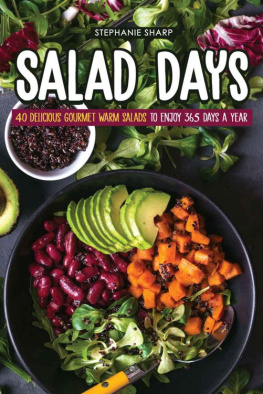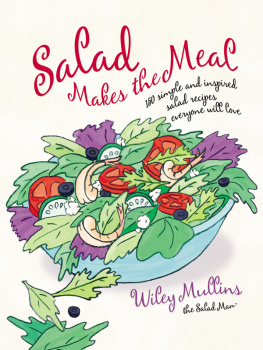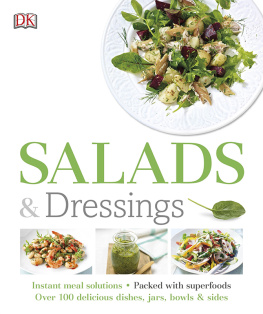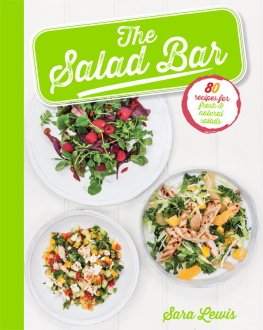

contents

How to Use This Ebook
Select one of the chapters from the and you will be taken to a list of all the recipes covered in that chapter.
Alternatively, jump to the to browse recipes by ingredient.
Look out for linked text (which is in blue) throughout the ebook that you can select to help you navigate between related recipes.
You can double tap images to increase their size. To return to the original view, just tap the cross in the top left-hand corner of the screen.
introduction
I have always been drawn to salads; I like the crunch of fresh vegetables, lively colourful leaves and punchy dressings. They sharpen my mind and give me energy yet still fill me up without leaving me sluggish and tired. I cant say the same for how my husband, Giancarlo, feels; he was pasta man and I was salad girl. Then within one month our world turned upside down. Giancarlo was told he was diabetic; he had to lose weight, give up sugar and eat less carbohydrates. This meant less pasta, no more cappuccino with sugar or cakes and biscuits. Then just weeks later he was told he was intolerant to gluten, badly so. Poor Giancarlo! He had to give up pasta, bread and pizza, all the things a traditional Italian man loves. On the bright side, he could eat salad and no one told him he shouldnt eat vegetables!
Months after this we found out that our son Giorgio is also gluten intolerant; he had been experiencing headaches, migraines and moments when he was so tired and weak he couldnt get up. So now we are pretty much gluten-free as a family and vegetables take centre stage. We grow plenty of our own and try to buy local and organic when they are available.
Salad is fresh, it is rich in nutrients and usually, though not exclusively, low in sugar and often gluten-free. This book, inspired by our new way of eating at home, follows the 90/10 rule in that we eat healthy food made from scratch 90 per cent of the time, treating ourselves to indulgences for the other 10 per cent. We like to eat loads of fresh vegetables, good meat and fish, wholegrains and as little sugar as possible. When we eat carbohydrates, such as pasta, potatoes, grains or sugary foods such as fresh or dried fruit, natural and processed forms of sugar, we eat them with protein and fat so as not to raise blood sugar levels. Looking back this is the way that Giancarlos family ate in Tuscany when he was growing up. Small portions of pasta were eaten with rag, meat went further with plenty of vegetables, and salad from the garden accompanied bread and cheese. His family were all lean and healthy. It was in the UK Giancarlo started to have huge portions of pasta, milky coffee all day, cravings for sweet fruits and sugary biscuits. To stop this I needed him and our children to cross over to the greener side of life.
Together we set out to discover new ways of eating vegetables and focused on salads from all corners of the world. We travelled to South East Asia, Morocco, Italy and the US to discover a new way of eating. We worked with family cooks and chefs from countries such as India, Nepal, Sri Lanka, Cambodia, North and South America, China, Japan, France, Kuwait, Greece, Peru, Korea and more. We wanted to understand and be confident in using unfamiliar ingredients to prepare dressings, marinades and spice rubs. We also learnt to cut vegetables differently, how presentation makes a huge difference, how to play with textures and balance sweet and sour.
From our travels we have broadened our culinary horizons. We have been inspired by other cultures and have been enthused by the people we have met, all those cooks who have generously brought their salads to life for us. We have hugely increased our repertoire of family meals and found a healthier way to eat.
Giancarlo and I are both enthusiastic teachers (in our cookery school) as well as restaurateurs. In writing this book we want to say look how easy this is to prepare, try this, its really good for you and tastes amazing and above all look how you can make everyday vegetables into a magnificent and moreish salad.

what is a salad?
The word salad comes from herbe salato, meaning salted leaves, referring to a bowl of dressed leaves, and dates back to ancient Rome and possibly before. Pliny, the ancient Roman writer, wrote to his friend about a salad kept cool with snow and reprimanded him for being too busy with dancing girls to notice this amazing phenomena.
The Italian gardener and writer Castelvetro was horrified by the eating habits of the English in the 1600s and wrote a whole book about how we should eat more salad. He didnt want us to waste the herbs and leaves around us and wanted us to use a greater variety of them. As history repeats itself, I learned of the current trend of using the whole vegetable in a recent trip to New York. Leftover parts of vegetables, such as carrot tops, beetroot leaves and broccoli stalks can be used to provide further nutrients and varying textures to make a salad far more interesting, see the .
Salad means different things to different people. For some it means cold but then salad can be warm, it is often chopped but then a whole lettuce or whole dressed beans are still salad. Does it have to contain leaves or something raw? No, sometimes it is entirely made with cooked, dressed vegetables. We have also included a variety of dips which are not strictly salads on their own but play a big part in the whole salad picture. And there is meat, chicken and fish as well as tofu and bean salads for additional protein. To us, salads are plant-based meals and have some sort of dressing.
what makes a good salad?
Start with the ingredients. What is in the fridge and needs using? What is in season and at its prime in the shops? Perky carrots and crisp lettuce need no more than a good dressing or dip, but dont discard limp coriander, make it into . Pick your ingredients from a tree or a shelf and assemble. That is salad.
textures
This is probably the most important lesson I have learned writing this book. Using a variety of textures can make a salad exciting, different and generally more loved. It is essential to find a balance between wet and dry as well as soft and crunchy. Salad appears at almost every meal now in our house, sometimes as the main event and sometimes as the supporting cast. We pull out ingredients from the fridge such as a couple of carrots, coarsely grate them into a pile, season them and squeeze a lemon over the top. I take a piece of cheese and use a peeler to make transparent shavings of it next to the carrot. We tear a little cooked chicken into shreds, pour over the best olive oil and add sea salt flakes and freshly ground black pepper. A handful of soft leaves, slices of pepper, chewy grains or cooked beans is mixed with a few crunchy toasted seeds or nuts and a little homemade dressing. It is vibrant, fresh and balanced with plenty of varying textures. The ingredients are not necessarily tossed together, they are in piles so fussy diners can avoid peppers or coriander (you know who you are!). Supper in less than 20 minutes.
Next page

